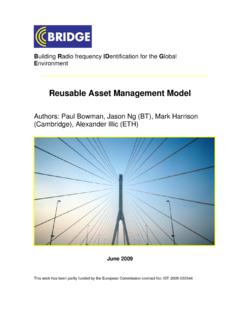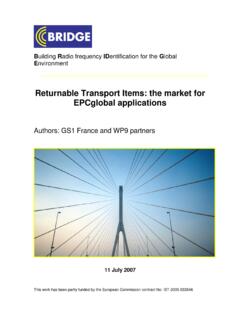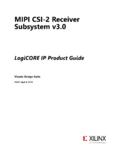Transcription of Building Radio Frequency Identification Solutions for the ...
1 BRIDGEB uilding Radio Frequency Identification Solutions for the Global EnvironmentFINAL report 2006 -2009 October 2009 SIXTH FRAMEWORKPROGRAMMED isclaimerThe bridge consortium (GS1, GS1 UK, GS1 France, GS1 Germany, GS1 Spain, GS1 Poland, GS1 China, Auto-ID Labs Cambridge, ETH Zurich, Fudan, UPC Barcelona, TUG Graz, Carrefour, B n dicta, Kaufhof, gardeur, Nestl UK, Sony, Northland, COVAP, BT, SAP, AIDA, CAEN, Confidex, AT4 wireless, UPM Raflatac, Verisign UK, Melior, Domino and JJ Associates) is providing this final report as a service to interested parties. Although efforts have been made to ensure that this publication is correct, reliable, and technically accurate, the bridge consortium makes no warranty, express or implied, that this publication is correct, will not require modification as experience and technological advances dictate, or will be suitable for any purpose or workable in any application, or otherwise.
2 Use of the publication is with the understanding that the bridge Consortium has no liability for any claim to the contrary, or for any damage or loss of any kind or 2009 (c) bridge ConsortiumBRIDGE is an Integrated Project supported by the European Commission s FP6 ProgrammeFor more information, visit contact us at 3 bridge Building Radio Frequency Identification Solutions for the Global EnvironmentMany ICT applications found a new life on the transition from analogue to digital. Some of them, such as the mobile phone, made the transition to the digital world fast. For other appliances, it took much longer, sometimes because the advantages of a transition were not obvious ( digital television) or sometimes because the challenges to migrate to the digital world and to open up a whole new domain of applications were too huge.
3 Radio Frequency Identification (RFID) has been for long in the last it became clear that RFID would find its way to get on track and eventually create a new paradigm, the Internet of Things, the European Commission decided to allocate some research grants to support these developments. The bridge project was the largest single RFID project receiving a grant from this research bridge consortium included academic partners in Cambridge (UK), Barcelona (Spain), Graz (Austria) and Zurich (Switzerland); technology partners in Tampere (Finland), Fudan (China), London (UK) and Viareggio (Italy); software partners in Walldorf (Germany), Malaga (Spain) and Uxbridge (UK); telecom partners in London (UK); GS1 standards organisations of most European countries and China.
4 And an extensive list of users in retail trade, the pharmaceutical supply chain, and manufacturing. bridge took on the challenge to harness their skills and experiences to drastically advancing the state of the art on RFID. After three years of intensive work the list of achievements is remarkable: Low cost readers and smart shelves, Building blocks for a practical deployment in the retail supply chain have been developed and prototyped for many sectors. Pilots have convincingly demonstrated the real benefits of the technology and will serve as best practices to educate prospective users. The bridge discovery services activity met its ambition of Building RFID-tagged object search functionality comparable to what search engines deliver today for content on the Internet.
5 This bridge investment in discovery services has been recognised by industry as the single largest effort of this kind in the world. Although early RFID applications made abstraction of security and data protection issues that can result from a mass deployment of the technology, bridge dedicated work to these security issues. Without doubt this work will result in a new generation of RFID tags, readers and applications that can ensure a higher level of security and data protection than today s state of the art Solutions . bridge was present on stage at many European and international events to disseminate the knowledge it gained in the project and to create the momentum that should lead to a more competitive European industry in this new reborn RFID conclude, bridge s focus on research along with a growing international presence underscored its commitment to a longer-term focus at the time when RFID technology appeared to be an enabling technology for developing the Internet of Things and Internet of Services.
6 Thanks to its groundbreaking work in moving a technology from a lab environment, out of the analogue age, to a mass market and into the digital world, maybe even the virtual world when objects find their identity on the Future Internet, bridge has made a positive contribution to industry and society, primarily in Europe but also in a global the European CommissionHead of Unit for RFID, G rald SantucciBRIDGE Project Officer, Florent FrederixG rald SantucciHead of Unit for RFIDE uropean CommissionDirectorate General Information Society and MediaFlorent FrederixBRIDGE Project Officer European CommissionDirectorate General Information Society and Media4 bridge Building Radio Frequency Identification Solutions for the Global EnvironmentIt has been a privilege to work for more than three years with a dedicated team of close to 100 researchers and business executives from the 31 organisations member of the bridge consortium.
7 The journey started in May 2005, with the idea to develop a response to a call for projects issued by the European Commission. Following a complex evaluation and negotiation process, the bridge project started officially in July 2006. Thirty-one organisations signed up to form the consortium that would implement the 150 pages business plan over the 3 years project life, representing a good balance between Universities, User companies, Solution Providers and Standard bodies. The overall budget of the project was evaluated at 13 million euros in terms of work efforts, investments and expenses.
8 The European Commission committed to a maximum funding of 7,5 million euros, provided that the work plan was executed properly and the project deliverables met the quality requirements. The project progress was reviewed every 6 months by a panel of experts appointed by the Commission for this purpose. The periodic reviews were typically conducted through a 2-days meeting between the bridge leadership and the independent the course of the project, several patents were filed by participating organisations. A number of new hardware and software products based on innovative features developed by the research teams were commercialised.
9 A start-up company was launched to promote a revolutionary concept of smart shelves From the bridge Coordinatorembedding RFID readers and antennae. The project issued several important contributions to standard bodies in the areas of sensors, security and Discovery services. The business work packages identified the opportunities, established the business cases and performed trials and implementations in various sectors including anti-counterfeiting, pharmaceuticals, textile, manufacturing, re-usable assets, products in service and retail non-food items. A comprehensive set of education and demonstration material was produced.
10 Many of the deliverables, documents, presentations, software tools, are publicly and freely available from the public web site. We strongly encourage anyone who has an interest in the RFID technology and its applications to make use of these valuable project was organised around fifteen work packages. I would like to thank particularly the work packages leaders who were responsible for the execution of the project plan in their areas. I would also like to thank the European Commission for having made this project possible. The formalism of the project structure and the reporting overheads are constraining but they are at the same time useful and probably indispensable to successfully run an ambitious project like aim of this brochure is to provide an overview of the work that has been accomplished by the bridge project.











